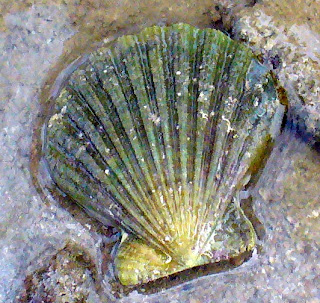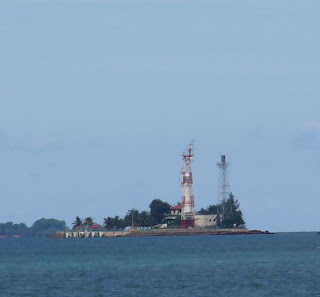It was a beautiful Sunday morning when we depart from Marina South Ferry Terminal to Pulau Semakau, no low-hanging dark clouds was spotted and the sun was slowly rising from the east (picture below).
 It looks like it’s going to be a great day for another inter-tidal walk and my first day of formal co-guiding.
It looks like it’s going to be a great day for another inter-tidal walk and my first day of formal co-guiding. How does it look like to you (picture below)?
 Cutting the long story short, eventually we managed to cross the forest trail with minor incident (just a few excitment here and there due to the minor flood occurrence on the forest trail =P) before reaching the inter-tidal zone for our walk.
Cutting the long story short, eventually we managed to cross the forest trail with minor incident (just a few excitment here and there due to the minor flood occurrence on the forest trail =P) before reaching the inter-tidal zone for our walk. 
Discovery Note:
1. Although people commonly call them star fish, we prefer to call them sea stars. As they are not fishes.
2. If you look on the underside of the sea star, you will find the tube feet of the sea star.
3. These tube feet are used for walking, handle food as well as breathing, talk about multi purpose!
4. Sea stars get stressed when out of water, so please don’t take them out of the water for too long.
Second ‘discovery’ was spotted after the usual crossing of the sea grass lagoon, two sandfish sea cucumbers (picture below),

Discovery Note:
1. The sandfish sea cucumber is the species of sea cucumber which people consume. But they contain toxins, so it must be properly prepared before consumption.
2. To repel predators or when stressed, a sea cucumber might expel their innards or ‘vomit’. And if too much of their innards are expelled, they might die off as a result.
3. So please handle them with care, and don’t stress them out. In short, handle gently. =)

Discovery note:
1. They are actually sea slugs, which are molluscs without a shell.
2. They are hard to spot as their skin often match the algae-cover rock, sand and sediment which can get stuck on it also helps to add on to its already great camouflage.
3. They are able to survive out of water as they have modified gills which allow them to breathe air.
Side note:
Some of us were handling the sea slug with our hands, only to discover how ‘slimy’ it was. And Helen (my ‘supervisor’) was commenting that it might shit on our hands and that ‘lucky’ person to get its ‘prize’ in the end was actually me, talk about hitting the ‘jackpot’. -_-“
 Discovery note:
Discovery note:1. The common name to this is the Heart cockle. Yes, the cockle some of us eat.
2. The cockle lives in sand and mud in shallow water.
3. All cockles are hermaphroditic, which means they possess both the male and female sex organs (like the flatworm).
Fifth ‘discovery’ was the Chromodoris Nudibranch (picture below), (managed to ID this with help from Samson’s blog, thanks Samson!),

Discovery note:
1. Nudibranch is pronounced as 'noo-dee-brank' to rhyme with 'bank'.
2. They are called 'nudibranch' because they have naked gills and many of them have flowery-like external gills on their backs.
3. They contain and can secrete toxins. So don't touch them with your naked hands!

Discovery note:
1. They are named for their ability to inflate themselves to several times their normal size by swallowing water or air when threatened.
2. They have four large teeth, fused into an upper and lower plate, which are used for crushing the shells of crustaceans and mollusks, their natural prey. They also enjoy the occasional bloodworm
3. The eyes and internal organs of most puffer fish are highly toxic, but nevertheless the meat is considered a delicacy in Japan and Korea.
 Discovery note:
Discovery note:1. Nudibranchs have a pair of tentacles which is believed to help them 'sniff' out prey and potential mates.
Eighth 'discovery', the highlight of Semakau inter-tidal walks, the knobbly sea star (picture below),
 Discovery note:
Discovery note:1. Their name comes from the presence of knobs on their topside.
2. Although they are brightly coloured and covered with knobs and spikes, they are not venomous, so you can touch them!
Sidenote:
As it is the first time, i am 'guiding', so a first group shot with the knobbly~
Team Sea slugs, gather and photo positions and cheese!

Ninth 'discovery' was the spider couch (picture below),
 Underside of the spider couch (picture below),
Underside of the spider couch (picture below), Discovery note:
Discovery note:1. This beautiful large shell is considered vulnerable due to habitat degradation and over-collection for food and as ornaments.
2. Like its relative the Gong-gong, it has a sickle-shaped operculum attached to a strong foot that is used to "pole-vault" along the sea bottom.
3. Being rather speedy for a snail, it has large eyes to see where it is going (notice its eyes on its underside).
4. The flared shell helps to keep it from flipping over as it "hops" along.
Tenth 'discovery' was a carpet anemone (picture below),
 Discovery note:
Discovery note:1. They have stinging cells in their tentacles, usually these tentacles are only exposed under water, but there have been cases where people have been stung when these are touched when these anemones are above water, so for your own safety, don't touch them with your naked hands.
2. They lack an anus, so they split out any indigestible food through its mouth.
Eleventh 'discovery' were some egg capsules from an unknown marine animal.

Twelfth 'discovery' is the logo of a famous company, the scallop (picture below),
 Discovery note:
Discovery note:1. Scallops are filter feeders - they open their shells slightly during high tide to suck in water and collect edible particles.
2. At low tide, they will shut their shells tightly.
3. Scallops can also "swim" by flapping their valves.
As the tide was coming in, we had to leave the inter-tidal zone soon and so we went back through the forest trail and back up to the waiting area.
At the waiting area, one of the participates was lamenting that her jeans was so wet that she couldn't stand it. So the solution she had in mind was to borrow a pair of scissors from a friend, and 'redesigned' her jeans, (i actually took the picture below, as Helen as calling out to me to blog this, then i was thinking, "why not".. :P)
 Anyway, after the inter-tidal walk, everyone was ushered onto the NEA bus and given a land fill tour by me (a better talk this time round, guess the notes i prepared helped me a bit) and headed towards the most southern part of Semakau where we could see the most southern part of Singapore, the Raffles Lighthouse (picture below),
Anyway, after the inter-tidal walk, everyone was ushered onto the NEA bus and given a land fill tour by me (a better talk this time round, guess the notes i prepared helped me a bit) and headed towards the most southern part of Semakau where we could see the most southern part of Singapore, the Raffles Lighthouse (picture below),
This nice flower was spotted at the most southern part of Semakau (picture below),

As according to the program, everyone then proceeded to the Marine transfer station and finally to the NEA conference room for a video presentation before we left for main-land Singapore.
Before i sign off, i would like to thank all 'Sea Slugs' again for their participation for this walk and making this walk an enjoyable experience for me. =)
and also Meanwhile, Bye, Semakau~
No comments:
Post a Comment